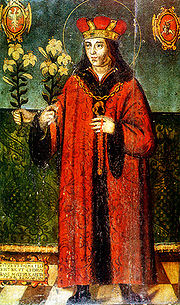Prominent Poles
Kazimierz Jagiellon (Saint Casimir), Roman Catholic Saint canonized in 1522, Prince of Poland, patron saint of Poland, Lithuania, and youth.

Born: October 3, 1458, Cracow
Died: March 4, 1484, Grodno (presently Hrodna, Belarus)
Early days. He was the second son of King Kazimierz IV Jagiellonczyk (Casimir IV) and Queen Elizabeth, an Austrian princess, the daughter of Albert II, Emperor of Germany and King of Bohemia and Hungary. Casimir's elder brother, Wladyslaw (Ladislaus), became King of Bohemia in 1471, and King of Hungary in 1490. His four younger brothers, Jan I Olbracht (John I Albert), Aleksander (Alexander), and Zygmunt I Stary (Sigismund I the Elder) in turn occupied the Polish throne, while Fryderyk (Frederick), the youngest, became Archbishop of Gniezno, Bishop of Cracow, and finally cardinal, in 1493. The early training of the young princes was entrusted to Father Dlugosz, the Polish historian, a canon at Cracow, and later Archbishop of Lwow (presently Lviv, Ukraine), and to Filippo Buonaccorsi, called Callimachus. Father Dlugosz was a deeply religious man, a loyal patriot, and like Callimachus, well versed in statecraft. Casimir was placed in the care of this scholar at the age nine, and even then he was remarkable for his ardent piety.
Adult life. When Casimir was thirteen he was offered the throne of Hungary by a Hungarian faction who were discontented under King Matthias Corvinus. Eager to defend the Cross against the Turks, he accepted the call and went to Hungary to receive the crown. He was unsuccessful, however, and returned a fugitive to Poland. The young prince again became a pupil of Father Dlugosz, under whom he remained until 1475. Later his father, King Kazimierz IV, had initiated him well into public affairs and when his brother Wladyslaw, ascended to the Bohemian throne, Casimir became heir-apparent to the throne of Poland. When in 1479 the king went to Lithuania to spend five years arranging affairs there, Casimir was placed in charge of Poland, and from 1481 to 1483 administered the State with great prudence and justice. About this time his father tried to arrange for him a marriage with the daughter of Frederick III, Emperor of Germany, but Casimir preferred to remain single. Shortly afterwards he fell victim to a severe attack of lung trouble, possibly tuberculosis, which, weak as he was from fasting and mortifications, he could not withstand. While on a journey to Lithuania, he died at the court of Grodno. His remains were interred in the chapel of the Blessed Virgin in the cathedral of Wilno (presently Vilnius, Lithuania). St. Casimir had great charms of person and character, and was noted particularly for his justice and chastity. Often at night he would kneel for hours before the locked doors of churches, regardless of the hour or the inclemency of the weather.
Recognition The hymn of St. Bernard of Clairvaux, "Omni die dic Marix mea laudes anima", was long attributed to him. After his death he was venerated as a saint, because of the miracles wrought by him (according to the beliefs of the Roman Catholic Church). Zygmunt I, King of Poland, petitioned the Pope for Casimir �s canonization, and Pope Leo X appointed the papal legate Zaccaria Ferreri, Bishop of Guardalfiera, the Archbishop of Gniezno, and the Bishop of Przemysl to investigate the life and miracles of Casimir. This inquiry was completed at Turin in 1520, and in 1522 Casimir was canonized by Pope Adrian VI. Pope Clement VIII named 4 March as his feast. St. Casimir is the patron of Poland, Lithuania, though he is honored as far as Belgium and Naples. In Poland and Lithuania churches and chapels are dedicated to him, as at Rozana and on the River Dzwina near Polock, where he is said to have contributed miraculously to a victory of the Polish army over the Russians. In the beginning of the seventeenth century King Zygmunt III began at Wilno (presently Vilnius, Lithuania) the erection of a chapel in honor of St. Casimir, which was finished under King Wladyslaw IV. The building was designed by Peter Danckerts, of the Netherlands, who also adorned the walls with paintings illustrating the life of the saint. In this chapel is found an old painting renovated in 1594, representing the saint with a lily in his hand. Two other pictures of the saint are preserved, one in his life by Ferreri, and the other in the church at Krosno in southern Poland. His remains were interred in Wilno. There is a Chapel of Saint Casimir in Vilnius Cathedral where his remains rest. St. Casimir lived and reigned with great dignity and possessed great charm and character. Several miracles are ascribed to him. On June 11, 1948, Pope Pius XII named Saint Casimir the special patron of all youth. The towns of Kvedarna and Nemunaitis in Lithuania have Saint Casimir depicted on their Coat of Arms.
Sources:
This article uses, among others, material from:
New Advent (Catholic Encyclopedia)
supplemented with information from:
Wikipedia
Return to home page:
Prominent Poles
